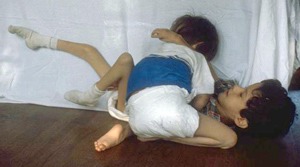Hesperian Health Guides
Arthrogryposis (Multiple Contractures From Birth)
HealthWiki > Disabled Village Children > Chapter 12: Common Disabilities Present at Birth > Arthrogryposis (Multiple Contractures From Birth)

Arthrogryposis means “curved joints.” Children with this disability are born with stiff joints and weak muscles. The unusual position of arms and/or legs may give a child the look of a wooden puppet.
In some children, both arms and legs may be severely affected. In others, only the legs or feet, or hands or arms may be affected.
A child born with clubbed feet and with one or both arms stiff with hands turned out, may have arthrogryposis.

upward or outward
stiffly; may be
dislocated
at elbows and weak
Rehabilitation of the child with arthrogryposis aims at helping the child do as much for herself as possible.
Some children with arthrogryposis are able to walk, especially if contractures are corrected. Correction of club feet and hip and knee contractures should begin gradually, and without forcing, soon after birth, with casting, positioning, and/or range-of-motion exercises.
 |
TYPICAL STANDING POSITION OF A CHILD WITH ARTHROGRYPOSIS If both hips are dislocated, surgery to put the bones back into their sockets is not usually helpful. The child walks as well without surgery. If only one hip is dislocated, surgery may help. |
Often, however, contractures of arthrogryposis can only be corrected by surgery. The possible benefits and losses which surgery may bring should be carefully evaluated. For example, a stiff elbow in a bent (contracted) position may be much better for eating than an elbow that has been straightened, and will not bend.
WARNING! A STIFF ELBOW IS OFTEN MORE USEFUL LEFT BENT
| MORE USEFUL | LESS USEFUL |
 | |
Most children with arthrogryposis have typical cognitive development. If given a chance, many can learn to do a lot of things for themselves. Often they try hard and are eager to learn. It is very important that these children be encouraged and helped to do as much as they can for themselves, and that they go to school. The following story may help give you an idea of the possibilities of a child with arthrogryposis.
SIMPLE STEPS TOWARD INDEPENDENCE—A true story
Gabriel is 7 years old. He lives with his family in Mazatlán, Mexico. He was born with arthrogryposis. Some of his joints are stiff and straight, others are stiff and bent. He lacks most of the muscles in his arms, legs, and hands. He cannot sit alone or lift a hand to his mouth.

Gabriel’s parents love him dearly and care for him tenderly. However, when he was born, doctors told them that nothing could be done for him. So his parents grew used to doing everything for him. As he grew older, they carried him in their arms, changed his diapers when he dirtied them, and gave him food in his mouth. They treated him like a baby—though he no longer was one.
When his mother learned of PROJIMO, she took Gabriel there, hoping that with surgery or special medicine, he might improve. The village rehabilitation workers at PROJIMO investigated all possibilities. They even took him to a famous hospital for children with disabilities. But the specialists said they could do nothing for Gabriel.
Fortunately, therapists who were visiting PROJIMO as instructors explained to the team that in fact there was a lot that could be done, not to help Gabriel walk, but to help him do more for himself—within his possibilities. The team began to work with the family, to help Gabriel become more independent.
Now, with the help of the village rehabilitation workers and his family, Gabriel is able to meet some of his basic needs for himself. He feels less like a baby and more like a young man. He has stopped using diapers; he asks when he needs to go to the toilet. He has learned to use his mouth like a hand, to hold and do things.

He has learned to feed himself. He swings his arm onto the table using his neck muscles, and hooks his hand over a spoon. Using the edge of the table and the rim of the dish to push against, he see-saws the spoon to his mouth. To drink he uses a straw with a bend in it.

Gabriel’s family has joined Los Pargos, an organized group of families of children with disabilities. He attends school in a specially-adapted wheelchair that he can move himself. He is learning to read, write, paint pictures, and to play with other children.
There is much more that Gabriel and his family will be able to achieve, now that they all see how much he can do for himself. Gabriel is happy and eager to learn more.
Various aids and adaptations can help children with arthrogryposis or similar disabilities become more independent:
 |
 |
 |
| Eating aids | Writing aids are shown in: "Making Therapy Functional and Fun" "Alternatives for a Child with Amputated Hands" "Aids for Reading, Writing, and Drawing". |
Wheelchair aids are shown in Chapter 64. |


